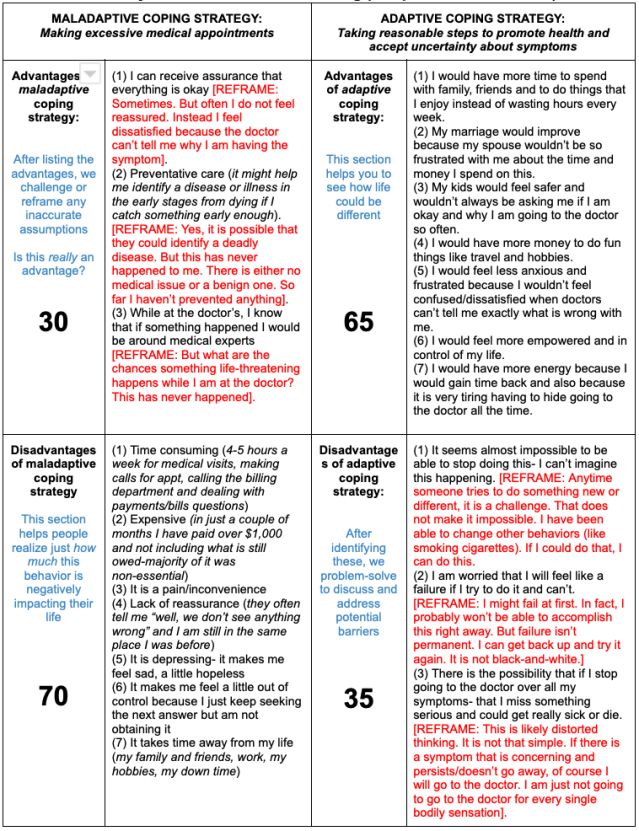Anxiety
What You Do to Cope With Health Anxiety Makes It Worse
A cost-benefit analysis to see how excessive medical visits make life harder.
Posted March 20, 2023 Reviewed by Ekua Hagan
Key points
- Health anxiety can lead to dysfunctional behaviors, due to a belief these behaviors will reduce one's anxiety.
- One type of dysfunctional behavior (or safety-seeking behavior) is reassurance-seeking, which includes making excessive doctor appointments.
- Cost-benefit analysis can help reveal how much a behavior (e.g. making excessive medical appointments) negatively impacts one's life.
You are stepping into the shower and you get dizzy. Huh, that’s strange, you think. Why would I suddenly become dizzy? I ate this morning. I’m not on any medication that would give me side effects. I didn’t get up suddenly or spin around. Something is not right. So you head on over to your primary doctor. She has no concerns and tells you everything is fine. People get dizzy from time to time, she says. You haven’t had another dizzy spell since the shower, so you take her word for it and go on with your life.
A few days later, you notice a sudden increase in your heart rate. You just walked up a flight of stairs but, still, your heart rate shouldn’t have increased that much. You recall the story of your old neighbor that had a heart attack at 38. You decide you shouldn’t take any chances and head over to urgent care right away. Work can wait, you tell yourself. After all, health comes first. And, over the next few weeks, this pattern continues.
Reassurance-seeking is a safety behavior
Safety-seeking behaviors are what we do to try and prevent or reduce the anxiety we are experiencing from a given symptom, bodily sensation, or bodily function. There are several different types of safety behaviors used to cope with health anxiety. Reassurance-seeking involves collecting information about a symptom to assess what kind of danger you might be in. This might include asking loved ones what they think about a symptom, searching the internet for information, or going to primary care offices, urgent cares, hospitals, or other medical facilities to consult with doctors and other medical professionals.
Safety behaviors might reduce anxiety in the short term but they most definitely increase it over the long term. Why? Because we learn to rely on them to achieve a sense of safety and rob ourselves of the opportunity to see that we most likely never needed them to begin with because we weren’t actually in danger. Also, the more we use safety behaviors, the more meaning and significance we give to them and, thus, the more dependent we become on them.
The rationale behind a cost-benefit analysis
Now, you might recognize, to some extent, that your reassurance-seeking safety behavior is making your life harder. When I introduce cost-benefit analyses, my clients often say to me, “Why do I need to analyze this? I already know that going to the doctor all the time is making things harder for me.” However, without even realizing it, you are likely assuming that the benefits of your safety behavior outweigh the costs. There is always something that motivates you to do it or, quite simply, you wouldn’t do it. For this reason, it can be helpful to take a closer look at the impact of your behavior with a cost-benefit analysis.
Completing the cost-benefit analysis
When I do cost-benefit analyses with my clients, we create a table. On the left side, we label the safety behavior or maladaptive coping strategy, which in this case is making excessive medical appointments. On the right side, we come up with a more adaptive coping strategy. In this case, the adaptive strategy is to take reasonable steps to promote good health (e.g. healthy eating, sleep, and exercise, following general medical guidelines and doctor recommendations). Beyond taking reasonable steps to ensure good health, we want to learn to accept the uncertainty of bodily sensations and symptoms.
We then list all of the advantages and disadvantages of both the maladaptive and adaptive coping strategies so we can get a bird’s eye view of everything. See the table below for details. Key points to consider about the different sections in the cost-benefit analysis:
- By looking at all of the advantages of the maladaptive coping strategy (making excessive medical appointments), one gets the opportunity to list out the reasons they think this is helpful. They then get the opportunity to challenge or reframe any inaccurate assumptions about this (reframes are in red).
- By looking at the disadvantages of the maladaptive coping strategy (making excessive medical appointments), one is able to realize just how much making excessive medical appointments makes their life harder.
- By looking at the advantages of a new, healthier coping strategy (taking reasonable steps to promote health and accepting uncertainty), one is able to see how life could be different if they changed things.
- By looking at the disadvantages of the new, healthier coping strategy (taking reasonable steps to promote health and accept uncertainty), one is able to identify any potential challenges or barriers to making this change so they can plan and prepare for those barriers.

So, how bad is this habit, really?
After you are done with this technique, take a minute to look over all the evidence (including the reframes). Start with the maladaptive strategy of making excessive medical appointments. If you had 100 points to divide up between the advantages and disadvantages, how many points would you give to the advantages section and how many points would you give to the disadvantages section? In this case, my client gave 70 to the disadvantages and 30 to the advantages. In other words, they believed that the disadvantages of making excessive medical appointments far outweighed the advantages.
You want to do the same for the more adaptive strategy, taking reasonable steps to promote health while accepting uncertainty about symptoms. My client assigned 65 points to the advantages of the adaptive coping strategy and 35 to the disadvantages. In other words, they decided that the advantages of taking reasonable steps and accepting uncertainty outweighed the disadvantages.
The cost-benefit analysis can really help one to look at their unhelpful behaviors more closely to see whether it is as beneficial to them as they assume it is. This is one of my favorite strategies to use with my clients because I often get to see them have an “aha” moment. After realizing the negative impact of their behavior, it can really motivate them to want to make some changes in their lives. Give this technique a try.




